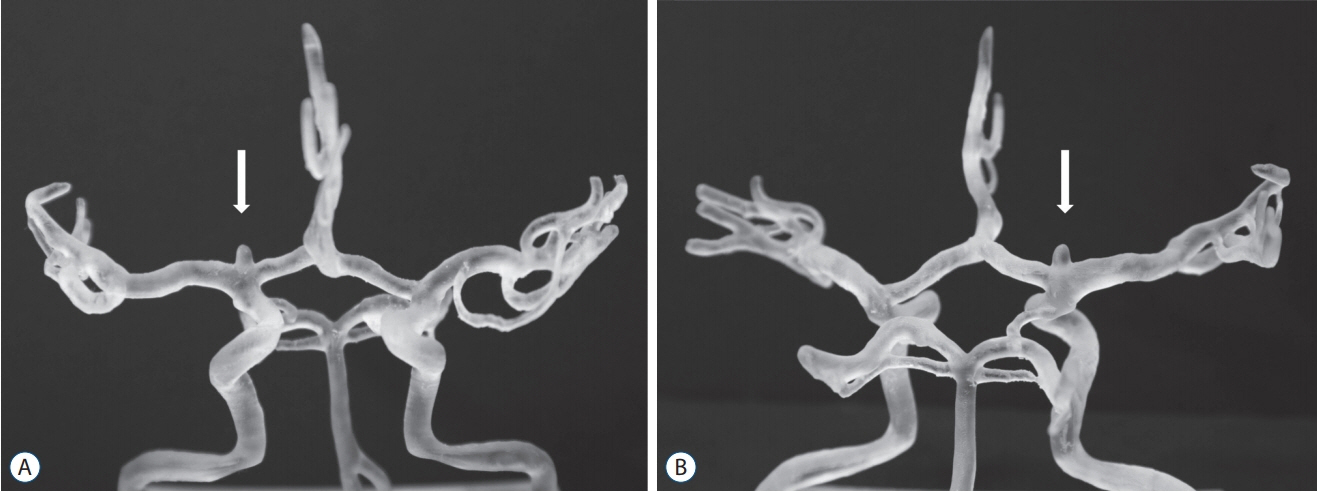J Korean Neurosurg Soc.
2019 Jul;62(4):398-404. 10.3340/jkns.2019.0092.
Obtaining Informed Consent Using Patient Specific 3D Printing Cerebral Aneurysm Model
- Affiliations
-
- 1Department of Neurosurgery and Medical Research Institute, Pusan National University Hospital, Pusan National University School of Medicine, Busan, Korea. medifirst@pusan.ac.kr
- KMID: 2463670
- DOI: http://doi.org/10.3340/jkns.2019.0092
Abstract
OBJECTIVE
Recently, three-dimensional (3D) printed models of the intracranial vascular have served as useful tools in simulation and training for cerebral aneurysm clipping surgery. Precise and realistic 3D printed aneurysm models may improve patients' understanding of the 3D cerebral aneurysm structure. Therefore, we created patient-specific 3D printed aneurysm models as an educational and clinical tool for patients undergoing aneurysm clipping surgery. Herein, we describe how these 3D models can be created and the effects of applying them for patient education purpose.
METHODS
Twenty patients with unruptured intracranial aneurysm were randomly divided into two groups. We explained and received informed consent from patients in whom 3D printed models-(group I) or computed tomography angiography-(group II) was used to explain aneurysm clipping surgery. The 3D printed intracranial aneurysm models were created based on time-of-flight magnetic resonance angiography using a 3D printer with acrylonitrile-butadiene-styrene resin as the model material. After describing the model to the patients, they completed a questionnaire about their understanding and satisfaction with aneurysm clipping surgery.
RESULTS
The 3D printed models were successfully made, and they precisely replicated the actual intracranial aneurysm structure of the corresponding patients. The use of the 3D model was associated with a higher understanding and satisfaction of preoperative patient education and consultation. On a 5-point Likert scale, the average level of understanding was scored as 4.7 (range, 3.0-5.0) in group I. In group II, the average response was 2.5 (range, 2.0-3.0).
CONCLUSION
The 3D printed models were accurate and useful for understanding the intracranial aneurysm structure. In this study, 3D printed intracranial aneurysm models were proven to be helpful in preoperative patient consultation.
MeSH Terms
Figure
Cited by 1 articles
-
3D-Printed Disease Models for Neurosurgical Planning, Simulation, and Training
Chul-Kee Park
J Korean Neurosurg Soc. 2022;65(4):489-498. doi: 10.3340/jkns.2021.0235.
Reference
-
References
1. Aoun RJ, Hamade YJ, Zammar SG, Patel NP, Bendok BR. Futuristic three-dimensional printing and personalized neurosurgery. World Neurosurg. 84:870–871. 2015.
Article2. Dong M, Chen G, Li J, Qin K, Ding X, Peng C, et al. Three-dimensional brain arteriovenous malformation models for clinical use and resident training. Medicine (Baltimore). 97:e9516. 2018.
Article3. Kimura T, Morita A, Nishimura K, Aiyama H, Itoh H, Fukaya S, et al. Simulation of and training for cerebral aneurysm clipping with 3-dimensional models. Neurosurgery. 65:719–725. 2009.
Article4. Knoedler M, Feibus AH, Lange A, Maddox MM, Ledet E, Thomas R, et al. Individualized physical 3-dimensional kidney tumor models constructed from 3-dimensional printers result in improved trainee anatomic understanding. Urology. 85:1257–1261. 2015.
Article5. Mashiko T, Kaneko N, Konno T, Otani K, Nagayama R, Watanabe E. Training in cerebral aneurysm clipping using self-made 3-dimensional models. J Surg Educ. 74:681–689. 2017.
Article6. Mashiko T, Otani K, Kawano R, Konno T, Kaneko N, Ito Y, et al. Development of three-dimensional hollow elastic model for cerebral aneurysm clipping simulation enabling rapid and low cost prototyping. World Neurosurg. 83:351–361. 2015.
Article7. Mitsouras D, Liacouras P, Imanzadeh A, Giannopoulos AA, Cai T, Kumamaru KK, et al. Medical 3D printing for the radiologist. Radiographics. 35:1965–1988. 2015.
Article8. Ploch CC, Mansi CSSA, Jayamohan J, Kuhl E. Using 3D printing to create personalized brain models for neurosurgical training and preoperative planning. World Neurosurg. 90:668–674. 2016.
Article9. Rengier F, Mehndiratta A, von Tengg-Kobligk H, Zechmann CM, Unterhinninghofen R, Kauczor HU, et al. 3D printing based on imaging data: review of medical applications. Int J Comput Assist Radiol Surg. 5:335–341. 2010.
Article10. Ryan JR, Almefty KK, Nakaji P, Frakes DH. Cerebral aneurysm clipping surgery simulation using patient-specific 3D printing and silicone casting. World Neurosurg. 88:175–181. 2016.
Article11. Wurm G, Lehner M, Tomancok B, Kleiser R, Nussbaumer K. Cerebrovascular biomodeling for aneurysm surgery: simulation-based training by means of rapid prototyping technologies. Surg Innov. 18:294–306. 2011.12. Wurm G, Tomancok B, Pogady P, Holl K, Trenkler J. Cerebrovascular stereolithographic biomodeling for aneurysm surgery. Technical note. J Neurosurg. 100:139–145. 2004.13. Yang T, Tan T, Yang J, Pan J, Hu C, Li J, et al. The impact of using threedimensional printed liver models for patient education. J Int Med Res. 46:1570–1578. 2018.
Article
- Full Text Links
- Actions
-
Cited
- CITED
-
- Close
- Share
- Similar articles
-
- Legal Issues Concerning Informed Consent
- Three-Dimensional Printing Technology in Orthopedic Surgery
- A Survey on Physicians' Opinions about Informed Consent for Transfusion
- Enhancing Professional Awareness of Informed Consent : Safeguarding the Rights of Patients and Practitioners
- The Current Status of Informed Consent for Transfusion in Korea and Development of a Standard Informed Consent for Transfusion




